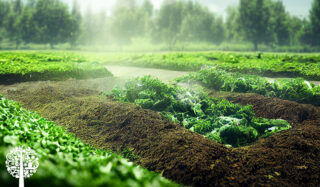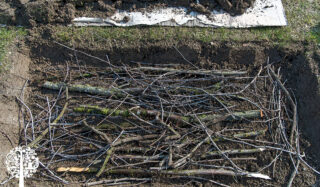Heat Waves Are The New Normal, So How Do We Adapt?
With another growing season underway, I am reflecting on our changing climate. I remember the long and cold spring of 2021, followed by a short summer and a wet winter. The 2022 season, on the other hand, was mellow from the start, with warm spring days and no late, unexpected frosts. As the summer solstice approached, it gradually became drier and hotter, with hose pipe bans starting in the south of England, Wales, and eventually in my county, one of the wettest in England. Ironically, I wrote an article about gardening in extreme wetness last year. Now, we face the possibility of not having rain for months.

An Emotional Rollercoaster
I found the first heat wave of mid-July last year to be rather splendid. I was on top of the moorland by a cold Yorkshire dam, interlacing refreshing swims with a chilled lie down under a shady tree with 36°C hot air stroking my face like I was in the Mediterranean. I felt happy, but in the back of my mind, I knew that if I were stuck on a London tube or any city flat with no airflow, or frankly, anywhere but where I was at the time, I would not be so smug. With worry, I observed local water dams getting lower, most breaking records and often uncovering long-forgotten rubbish or infrastructure like bridges from when they were still vibrant valleys and not water supply reservoirs. One of the local dams dropped 11 meters below the standard water line, with a cracking bottom resembling a desert. Plants and weeds began to grow, and sheep came down from nearby fields to graze. Dystopian, yet still beautiful.

I was initially excited about how many apples I would have thanks to the heat, but within weeks, I started noticing the smaller ones dropping and the larger ones being eaten by birds. The same thing happened to the plums; the late-developing ones were dense, bitter, and damaged from hungry beaks. It made me think of the animals and their food sources.
The worms and organic matter traveled deeper as the soil dried out. Reports of juvenile birds, hedgehogs, and badgers dying of hunger and thirst were heartbreaking.
It wasn’t long before my sweet, enormous grapes in the polytunnel started to drop like flies, with whole clusters at the end of the vine shriveling. I was inadvertently growing bitter raisins. With the hose ban in place and relying on water from a nearby spring, I realized I should not have taken it for granted. Meanwhile, we regularly witnessed stupidity, such as individuals watering their lawns or fiddling with spring water pipes to snitch more water for themselves with zero consideration for their neighbors or the environment.
Soil Science
I wondered what must be done to my allotment and many others nationwide. We need to be more prepared for these events that will likely roll in year after year. So, I began digging deeper into the world of soil science, familiarising myself with the attributes of Soil Organic Matter (SOM) and its properties; improved soil aggregation, water filtration, reduced compaction, and, most important, the capacity to hold water in the soil.
With numerous research studies and papers available, it is clear that increasing SOM benefits plant nutrition, but this statistic got me hooked: a 1% increase in SOM results in about 20,000 to 25,000 more gallons of available soil water per acre or acre-inch. Considering that most soils have only 1-2% SOM, there’s a lot of room for improvement. Having looked at the evidence provided mainly by regenerative cattle ranchers in the United States, there are reports of 10-15% SOM increases in the land. That’s a lot of water that is held in the ground. Similar examples of reversed desertification can be found when looking at Soil4Climate and their impressive work with the Massai tribe in Kenya (look them up!).
Following this trail, I figured out an action plan to implement this year so that my crops, the animals in my environment, and my sanity remain intact:
Increasing SOM In All Growing Areas
In acidic clay soil, this requires heavy mulching, adding compost, sand, coco coir, and biochar to break the clay structure. Activated Aerobic Compost Teas will also be on the cards.
Hugelkultur For The Win!

This is my favorite method of building raised beds these days. So much has been said about the Hugelkultur in previous articles, but seeing the benefits of Hugel beds two or three years down the road is mind-blowing. Water retention is spectacular, and plant growth is vigorous and pest-free. Last year, one of my beds fruited with Wood Blewit mushrooms, which have a bergamot fragrance and purple appearance, and come at a premium cost at a posh London market stall.
More Plants, Less Work!
No dig method (which, coincidentally, I came across in my first year of growing and can not recommend enough to any beginner gardeners), keeping the plants in the soil year-round, and integrating livestock into crop rotations. It may not be easy for many to do the latter, but befriending a local chicken group may get you some good chicken manure, which can do the job until you get your own herd of native cows.
Shading In The Greenhouse And The Garden
This may not seem like a solution initially, but shading is practical and can provide a difference of around 10°C, which can be a life or death matter for many plants and insects.
Keeping The Little Ones In Mind
The last but most important thing we can do is to support the animals mindfully. Water bowl availability is paramount in several corners of the garden, both on the ground and higher up for different clientele. In bird nesting season, avoid feeding dry seed, as it discourages young parents from looking for bugs and spiders, essential food for their fledglings. Environment and shelter are the most important; a little messy corner in the garden hasn’t caused any harm to humans, but for a hedgehog needing respite from the scorching sun, this may be the thing to save its day or life.
The heat and its consequences are inevitable. It will change how we grow, build houses, and function as a society. The humanism in us must shine, and the drive to protect what we have left should spur us all into action, no matter how grand or small. The solutions for change are there; we must keep finding and perfecting them.




